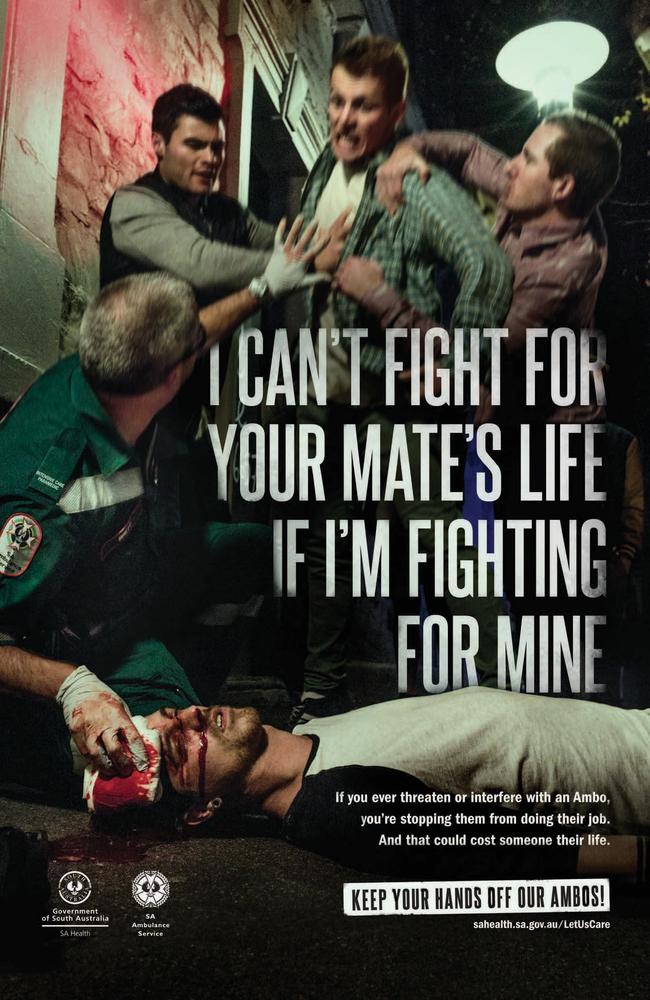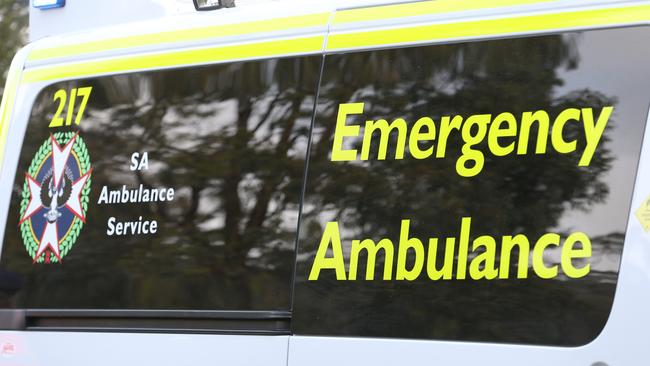Police deployed to protect paramedics from attacks, as study shows support for self-defence measures
POLICE escorts are being deployed during ambulance call-outs to 90 red-flagged addresses where 81 individuals have assaulted or threatened paramedics who were performing lifesaving work.
POLICE escorts are being deployed during ambulance call-outs to 90 red-flagged addresses where 81 individuals have assaulted or threatened paramedics who were performing lifesaving work.
A “no-go without escort” rule comes as assaults against ambulance officers have almost tripled from 52 in 2011-12 – the year records started – to 140 in 2017-18.
The latest figure is slightly down on the 164 assaults recorded in 2014-15, when a public awareness campaign started imploring bystanders not to harass paramedics.
The Sunday Mail can reveal the red-flag address figures as a landmark Australian study of ambulance officers in 13 nations shows support for officers to carry “chemical weapons”, including pepper spray, as a self-defence measure.
In South Australia, both the SA Ambulance Service and the Ambulance Employees Association – the union representing officers – say their preference is for defusing volatile situations and for police escorts, rather than weapons, at known risk addresses.
The study, led by Professor Brian Maguire of Central Queensland University, received responses from 1778 emergency medical services workers in 13 nations, including across Australia.
Of these, 633 reported being assaulted in the previous 12 months and 203 of them believed the incident could have been prevented.
“My earlier research has shown there is no occupational group in Australia that has a higher injury rate than paramedics,” Prof Maguire told the Sunday Mail.

The research found some support for chemical deterrents, physical restraints and self-defence courses, however the responses were not broken down by region.
It also found six areas where ambulance officers believe safety could be improved – four before attending incidents and two during incidents.
These were:
PRE-EVENT
HUMAN FACTORS: Improved knowledge of specific populations and de-escalation techniques were suggested. This would include better training to improve their understanding of specific population groups, developing a better understanding of personal safety and becoming proficient in de-escalation techniques and self-defence measures.
EQUIPMENT FACTORS: The use of physical restraints and chemical deterrents including pepper stray and the tranquilliser ketamine.
“Our study indicates that some EMS personnel see a role for weapons in their self-defence,” it says.
The study noted weapons carried by EMS personnel for self-protection overseas included knives, guns, mace and pepper spray. However, in this study it says: “None of the respondents suggested that a bullet or stab-proof vest would have prevented the incident. None of our respondents claimed that having a gun would have helped prevent the violent incident.”
It also noted the value of physical and chemical restraints would need to be weighed against the risks to EMS staff of carrying such equipment.
OPERATIONAL FACTORS: Having systems in place to provide advance warning of potentially violent patients, in places from nursing homes through to addresses that are ‘red flagged’ from previous incidents. Police would accompany ambulances on such occasions.
This is already the case in SA, where 81 individuals at 90 addresses are red flagged, so police attend if an ambulance is called.
SOCIAL FACTORS: Public awareness campaigns — as have occurred in SA — as well as agency policies to better protect workers in potentially dangerous situations and also to ensure all incidents are reported, even ones where staff may be reluctant such as those involving patients with dementia.
DURING EVENT
HUMAN FACTORS: Moves to bolster situational awareness on the scene, taking into account whether factors such as fatigue may play a role in workers letting their guard down.
OPERATIONAL FACTORS: Better interagency co-operation and relationships to help defuse situations, including with police, fire brigades and nursing homes.

SA Ambulance Service has 33 people and 36 addresses red-flagged because of past assaults and a further 48 people and 54 addresses because of past threats, which require police attendance when an ambulance is called.
In a statement to the Sunday Mail, SA Ambulance Service did not outline its position on defensive weapons but stated it was constantly seeking to strike a balance between providing essential care while ensuring staff are not harmed.
The organisation has recently relaunched its public campaign, Keep Your Hands Off Our Ambos, in a bid to reduce aggression and assaults against ambulance officers and paramedics.
“Paramedics receive specialised training in risk assessment, verbal de-escalation and disengagement techniques to ensure their safety and that of the patient,” the statement said.
“SAAS crews conduct risk assessments for each call they respond to and, where risk is identified, crews work well with partner agencies like SAPOL to mitigate those risks.
“SAAS collaborates with these agencies to identify locations where individuals who may pose a threat to first responders reside and regularly reviews its records to ensure these addresses are current.
Ambulance Employees Association state secretary Phil Palmer said weapons could be turned against officers and its preference was to de-escalate, defuse and exit volatile situations, rather than “engage in combat”.
Mr Palmer said the union was always concerned for the safety of members in confronting situations, where people are usually “alcohol-fuelled or sometimes ice-fuelled”.
“As a union, we haven’t formed a view on whether officers should be given pepper spray but that may be a step too far. The problem is a weapon can be used against officers,” he said.
“We prefer defusing techniques and leaving the scene in a safe way.
“If a scene is unsafe, members should not enter until police are there.”
Mr Palmer said ambulance officers were trained in de-escalating and defusing techniques – and in some physical techniques including how to break a grip of an assailant – but not in self-defence such as martial arts.
“We don’t want them to become combatants – our role is to provide care,” he said.

